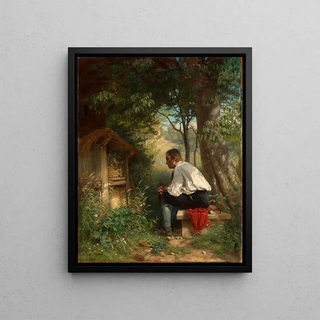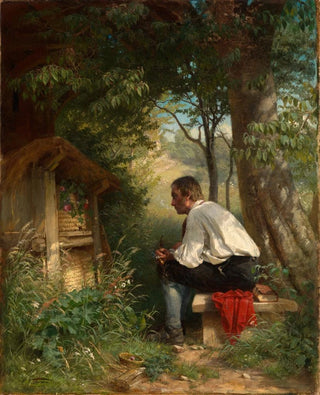Art print | L'amie des abeilles - Hans Thoma


View from behind

Frame (optional)
Art print of The Bee Friend - Hans Thoma – Captivating Introduction
In the vast panorama of art history, certain works stand out for their ability to capture the very essence of nature and human harmony. "The Bee Friend" by Hans Thoma is one of those creations that transports us to a world where the beauty of pollinating insects is celebrated with rare tenderness. This painting, both poetic and symbolic, evokes a communion between man and nature, a theme dear to the artist. By observing this piece, the viewer is invited to delve into a universe where childhood innocence meets the wisdom of nature, where bees, central figures, become messengers of life.
Style and uniqueness of the work
Hans Thoma's style, rooted in the symbolist movement, is vividly expressed in "The Bee Friend." His painting technique, characterized by bright colors and gentle forms, creates an atmosphere imbued with serenity. In this work, Thoma uses shades of green and yellow, evoking daylight filtered through the leaves of a lush garden. The delicate features of the characters, especially the child caressing a bee, testify to a sensitivity and attention to detail that define the artist's reputation. This painting does not merely depict a bucolic scene; it also evokes feelings of protection and respect for nature, encouraging the viewer to reflect on the role of bees in our ecosystem and their vital role in pollination.
The artist and his influence
Hans Thoma, born in 1839 in Germany, is often regarded as one of the most influential artists of his time. His career, spanning several decades, is marked by a constant search for harmony between man and nature. Thoma draws inspiration from popular tales and legends, incorporating folkloric elements into his works. His fascination with landscapes and rural scenes, coupled with a deep admiration for the simplicity of peasant life, allows him to create compositions that resonate with touching authenticity. His impact on the symbolist movement and on art

Matte finish

View from behind

Frame (optional)
Art print of The Bee Friend - Hans Thoma – Captivating Introduction
In the vast panorama of art history, certain works stand out for their ability to capture the very essence of nature and human harmony. "The Bee Friend" by Hans Thoma is one of those creations that transports us to a world where the beauty of pollinating insects is celebrated with rare tenderness. This painting, both poetic and symbolic, evokes a communion between man and nature, a theme dear to the artist. By observing this piece, the viewer is invited to delve into a universe where childhood innocence meets the wisdom of nature, where bees, central figures, become messengers of life.
Style and uniqueness of the work
Hans Thoma's style, rooted in the symbolist movement, is vividly expressed in "The Bee Friend." His painting technique, characterized by bright colors and gentle forms, creates an atmosphere imbued with serenity. In this work, Thoma uses shades of green and yellow, evoking daylight filtered through the leaves of a lush garden. The delicate features of the characters, especially the child caressing a bee, testify to a sensitivity and attention to detail that define the artist's reputation. This painting does not merely depict a bucolic scene; it also evokes feelings of protection and respect for nature, encouraging the viewer to reflect on the role of bees in our ecosystem and their vital role in pollination.
The artist and his influence
Hans Thoma, born in 1839 in Germany, is often regarded as one of the most influential artists of his time. His career, spanning several decades, is marked by a constant search for harmony between man and nature. Thoma draws inspiration from popular tales and legends, incorporating folkloric elements into his works. His fascination with landscapes and rural scenes, coupled with a deep admiration for the simplicity of peasant life, allows him to create compositions that resonate with touching authenticity. His impact on the symbolist movement and on art






